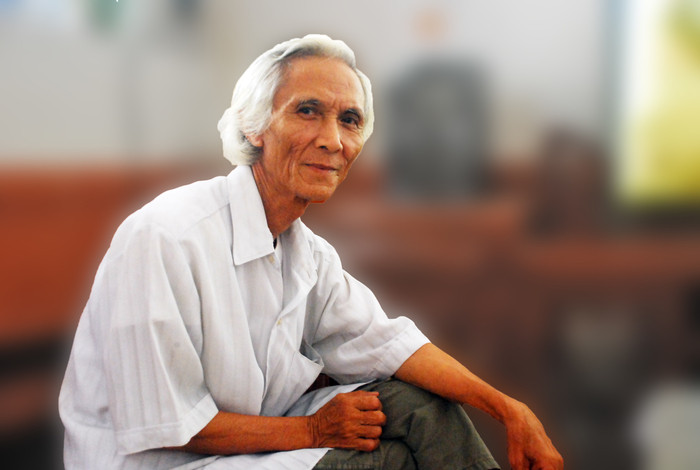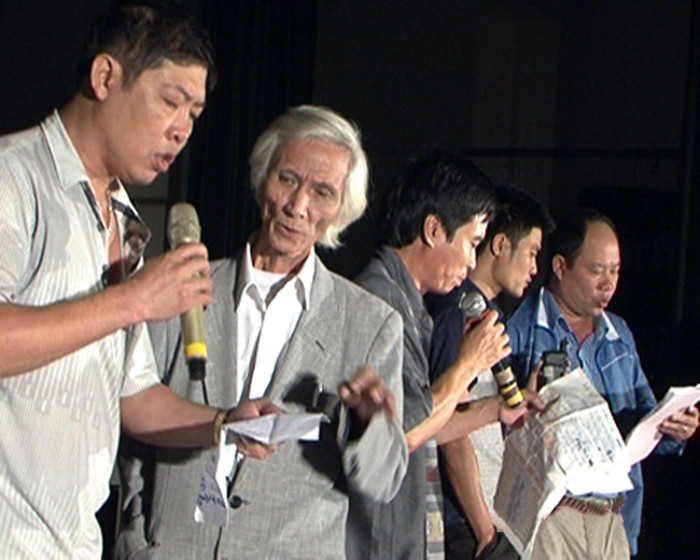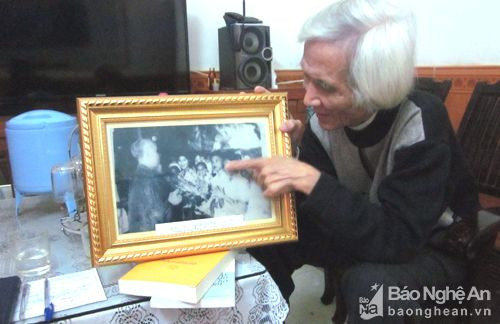Farewell to the creator of the four-flower melody
(Baonghean) - The news of Meritorious Artist Dinh Bao's passing has shocked many people.
People know him as a pillar artist of the province's Cheo stage, the creator of the four-flower melody, a devoted teacher of folk songs... On their personal Facebook pages, some artists share their endless grief for the artist who devoted his whole life to raising the wings of the homeland's songs. We remember the simple artist with white hair, worn-out shirt, in a small room and shared with us the joys and sorrows of a day exactly 3 years ago...
The village boy and his dream of "going to the performing arts"
Artist Dinh Bao is the third child in a family of 6 children, born in Trung Phuong village, Dien Minh commune (Dien Chau), a countryside famous for Ke Lu ca tru. Perhaps, it was thanks to the countryside and the country customs that made him know and love folk songs and love performing since his childhood.
When he was a barefooted boy, artist Dinh Bao often skipped school to watch performances in the commune and district. The stories on stage, the acting and singing of the actors captivated the country boy at that time, wishing that he could transform into another person, live another life, behind that glorious stage curtain. Dinh Bao's only wish at that time was to "go to the art troupe".
 |
| Meritorious Artist Dinh Bao. Photo: Thu Huong |
The artist told us that in his hometown, there used to be a group of women who worked as fabric weavers and fabric guild singers. Some spun cotton, some wove cotton, some rolled cotton, and sang as they worked. He liked that atmosphere and the songs so much that he followed the women around to listen. There were many days when his parents found him asleep in the corner of the neighbor's yard.
At that time, his family only had one bicycle that kept slipping, but every time he heard that there was a performance practice in the district, he would ask his mother to take his bicycle to see it. Every day when he came back, his hands and face were covered in grease because the bicycle kept slipping…
Then he told about the endless corn fields of his hometown, about the fields of yellow rapeseed flowers in the sunlight, about the amazement of a boy who dreamed early, about the hardships of his parents, the scoldings of their son who was absorbed in singing but then they themselves saved up so that he could pursue his passion. Perhaps it was because of those memories that he felt indebted to his homeland, indebted to folk songs...
At the age of 16, while studying in grade 7 at a village school, Meritorious Artist Dinh Bao played the role of Ha in the skit “What is the most precious thing” at the Provincial Mass Arts Festival. His role left a deep impression on the judges and the audience. After a while, he was unexpectedly approached by the Nghe An Arts Troupe.
At that time, Dinh Bao was washing grass by his pond when he heard someone asking about him. He was recruited directly into the Art Troupe. He told us that until now (2014), he still remembers clearly the feeling of excitement and joy he felt at that time.
Happiness on stage
In 1961, at the age of 17, Dinh Bao was recruited into the Nghe An Cheo Troupe. He said that he was very happy when his wish of "going to the art troupe" was fulfilled and even happier because thanks to it, he got to meet Uncle Ho.
After joining the Cheo troupe, he was assigned the role of the net lifter in the famous Cheo play of that time, “The Girl of the Lam River”. This play was invested in to be performed for Uncle Ho and the Party Central Committee at the Presidential Palace. The net lifter in the play is a person on a revolutionary mission, responsible for delivering information and confidential documents to secret agents, requiring flexible and skillful acting.
Dinh Bao performed quite successfully. After watching the play, artist Dinh Bao always remembered Uncle Ho's pat on the shoulder and his compliment: "You are still young but you acted very well, if you try hard you will surely succeed." It was that encouragement that helped him believe in his path and be more passionate about the career he chose.
 |
| Meritorious Artist Dinh Bao practices with actors from Nghe An Folk Song Theater. Photo: Internet |
The “lifetime” roles of artist Dinh Bao are not the main characters (in fact, he rarely plays main roles) but mainly supporting roles, simple country people, or clowns. His lively, witty, flexible, creative and extremely natural features have attracted the audience. That is why, even though it is only a supporting role, people always remember a charming Dinh Bao on stage. And those roles, he feels, “fit” him, they make him satisfied.
No matter what role he plays, he doesn’t care much about his position, but what he cares about most is whether he plays the role well and leaves an impression on the audience. Therefore, artist Dinh Bao has spent a lot of time and effort practicing the role, learning from his predecessors and from books. He is so absorbed in practicing that he forgets to eat, and some people even think he has “mental problems” when he is doing something, or walking on the street, but still gesticulating to “get into character” like on stage.
Among hundreds of roles, we can mention his marks that people still remember until now, such as the role of Phi in the folk play: "Not me" (this play participated in the National Performance Festival, won the Gold Medal), the role of the village official in the play "Mai Thuc Loan", the role of Giao in "Hat lua que ta"; the role of clown Thin in the play "Tam Cam"...
Not only is Dinh Bao's acting witty, he is also very meticulous in his costumes. He often does his own makeup to be able to convey his intentions, desires and aspirations to the public.
The creator of the four-flower melody
In the early 1970s, the Nghe An Folk Song Troupe was officially established. Passionate about acting, but with his skinny body, he could not take on many roles, so artist Dinh Bao joined the Folk Song Troupe in a new role: becoming an adapter and dubbing artist.
This was the period when the province had a policy of experimenting with the theatricalization of Nghe Tinh folk songs. Dinh Bao, along with famous artists of the time such as Thanh Luu, Vi Phong, Van The, etc., experimented with composing melodies, dubbing melodies, and adapting literary scripts into folk dramas.
He participated in adapting and dubbing a series of folk song plays such as: "The Young King's Love Story", "The Soul of Stone", "Still Going to War", "The Grains of Our Homeland", "When the Team is Away", "The Raging Sea", "Power and Crime"..., dubbing for: "The Young King's Love Story", "Phan Boi Chau", "Nguyen Bieu", "Nguyen Du", "The Beauty Teaches Her Husband"...
Adapting folk opera is a difficult task because it requires both literary and theatrical knowledge, a talent for composing poetry, and a firm grasp of the rules of poetic forms; a firm grasp of opera melodies in general, and folk opera in particular; a grasp of the spirit, consistent actions, main images, and ultimate mission of the play.... Yet with all the passion, dedication, and talent, Dinh Bao and his colleagues succeeded. His adaptations have elevated him to the status of an author.
 |
| Meritorious Artist Dinh Bao talks about his memories of meeting Uncle Ho. Photo: NL |
In 1985, the Nghe Tinh Folk Song Troupe staged the play “Mai Thuc Loan”. When Mai Thuc Loan was thrown into prison, no one had yet composed lyrics for this group to describe a meeting in prison filled with pain, longing, and worry. The original Nghe Tinh folk songs and newly composed songs could not convey the characters’ emotional changes.
People thought of many options, including asking great authors to write lyrics and melody for this “climax”. That night, Dinh Bao quietly returned home, he borrowed a guitar, transformed himself into the character’s mood to sing it mournfully and passionately… The next morning, he tried singing his composition to his friends and colleagues. Everyone was amazed, surprised and burst out: This is it, exactly what “we” need! He named that melody “tu hoa”.
This tune is a combination of 4 (four) melodies of Vi, Giam, Tho Trung and Quan Tu Phu Dich in Cheo. When combining the characteristics of these 4 melodies, it describes the process of intense emotional changes of 2 characters: both painfully having to part, but also restraining the pain to advise each other, to promise to wait together for the day to meet again.
Since then, the four-flower melody has had a solid place on the folk stage, when it is necessary to express the character's mood in situations of intense conflict. And almost every Nghe Tinh folk play has four-flower melody appearing. Along with the times of performing everywhere, being recognized by the public, Dinh Bao's four-flower melody has become a unique "brand". And gradually, four-flower melody has become a folk melody...
Dedicated to folk songs
From being an actor, to researching, writing lyrics, and then giving birth to new melodies, until leaving the stage lights, artist Dinh Bao has always lived with folk songs. He is not only known for the above roles, but also became a person who researched, inspired and nurtured the source of folk songs. He traveled to the countryside where folk songs still existed to meet, collect and record them.
He is willing to become a free teacher for those who love folk songs. He accepted to teach folk songs on Nghe An Radio and Television, and taught at Nghe An College of Culture and Arts, at cultural centers, agencies, units, and schools in Ha Tinh province. He is not too fussy about pick-up and drop-off, just need an invitation, artist Dinh Bao takes a bus to each remote locality, spreading the burning love of folk songs in his heart...
Hearing the news that the simple artist, who devoted himself to the songs of his homeland, had passed away, many people were shocked by the sudden loss. Someone said that Nghe An folk music had a big void. Indeed, a big void without that silver hair and small figure…
TV

